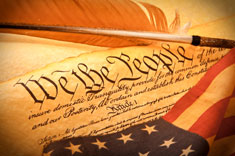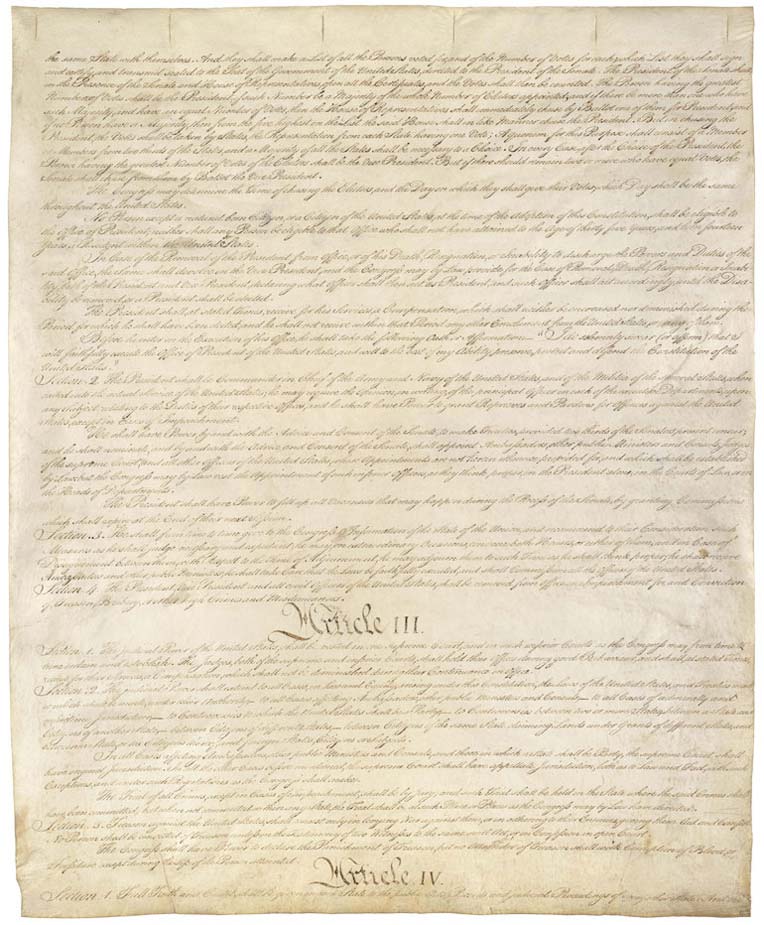| United States Constitution | |
|---|---|
 |
|
| The U.S. Constitution | |
| Preamble | |
| Articles of the Constitution | |
| I ‣ II ‣ III ‣ IV ‣ V ‣ VI ‣ VII | |
| Amendments to the Constitution | |
| Bill of Rights | |
| I ‣ II ‣ III ‣ IV ‣ V ‣ VI ‣ VII ‣ VIII ‣ IX ‣ X | |
| Additional Amendments | |
| XI ‣ XII ‣ XIII ‣ XIV ‣ XV ‣ XVI ‣ XVII ‣ XVIII ‣ XIX ‣ XX ‣ XXI ‣ XXII ‣ XXIII ‣ XXIV ‣ XXV ‣ XXVI ‣ XXVII | |
| View the Full Text | |
| Original Constitution | |
| Bill of Rights | |
| Additional Amendments |
Article 2 of the Constitution is one that states the executive branch is the government of the United States. The executive branch is the governmental branch that has the power, responsibility, and authority for administration. The executive branch includes the President, the Vice President, and other executive officers to include state officials, and other officials at the federal level.
Breakdown
The second article of the United States Constitution is broken down in to 4 distinct sections. Each of these sections are then broken down in to clauses, each one providing rules and guidelines that have to be followed, by those members who are a part of the executive branch of the government. The first section is broken down in to 8 clauses, and it basically breaks down the rules governing the President, and what his authority is.
Section 1: Roles of the President
 This section defines the roles of the President and of the Vice President. Each clause breaks down certain powers, restrictions, and definitive actions that each party can or has to take, based on certain situations, and different occasions when they are faced with decision making. Section one breaks down the Electoral College, how candidate is chosen, and how the President and vice President are eventually voted in to office.
This section defines the roles of the President and of the Vice President. Each clause breaks down certain powers, restrictions, and definitive actions that each party can or has to take, based on certain situations, and different occasions when they are faced with decision making. Section one breaks down the Electoral College, how candidate is chosen, and how the President and vice President are eventually voted in to office.
Clause 1
This clause vests the power to the President, stating they have the executive power. It defines the term of power for a period of 4 years, and assigns the Vice President, that will hold office for the same period of time.
Clause 2
Electors will decide on the President and Vice President, and these electors are generally chosen by the state legislatures. The number of senators and representatives for each state is what dictates the number of electors that the state is given.
Clause 3
Electors who are chosen then meet in their state to decide who will be the President and Vice President. It used to be that the individual with more votes would be President, but the 12th Amendment was added, which gave electors the deciding vote in the matter.
Clause 4
Clause 4 states that Congress decides when elections are held. States currently select electors on the Tuesday following the first Monday in November, and electors will then vote on the second Wednesday in the month of December.
Clause 5
States the requirements to be considered for Presidential office. It states that a candidate has to be at least 35 years of age, must be a natural born U.S. citizen, and they must have lived in the U.S. for a period of at least 14 years in order to be eligible.
Clause 6
Dictates what happens if the President dies, resigns, is impeached, or otherwise forced to leave office; in that case, the Vice President will take over, for the remaining period in the 4 year term. If the vice President is unable, it is Congress’s decision to select a suitable replacement, and this party will hold office for the remaining term.
Clause 7
Dictates the President’s salary, the fact that it cannot change while they are in office, and states they cannot receive any money from the state or the federal government, on top of their salary.
Clause 8
This final clause basically states that the President, in order to be sworn in, must take an oath before they are able to take office.
Section 2: Powers of the President
Dictates the powers of the President, and is comprised of only 3 clauses.
Clause 1:
States the President is the commander in chief of the military forces. The creation of a cabinet of senior advisers is also established here, and it is in charge of assisting the President in making decisions on this front.
Clause 2
States the President is required to get advice and consent from the U.S. Congress, prior to being able to make final decisions and binding decisions.
Clause 3
States the President has the power to assign certain offices while in power, but this power will end when the next Senate session begins.
Section 3: Responsibilities of the President
This section is broken down in to 5 clauses, dictating the President’s responsibilities.
Clause 1
Requires the President to keep Congress informed and give them information, through state of the union addresses, at regular intervals.
Clause 2
The President has the power to call sessions of the Senate, House of Representatives or both parties.
Clause 3
Dictates that the President is responsible for receiving any foreign ambassadors that come to the U.S.
Clause 4
The President is required to work, to ensure all laws are executed faithfully while in office.
Clause 5
The President’s power allows him to commission U.S. officers, including those in the military forces, when deemed to be necessary.
Section 4: Disqualification
The final section deals with impeachment of the President, the vice President, judges, and any other civil officers, based on certain conduct, or misconduct. Depending on certain actions that are taken, actions that are not taken, or other issues that arise, the President, as well as other officers, can be impeached, or removed from office, depending on a vote that is taken by other governing bodies.
This final section of Article 2 of the Constitution, basically states that the President, the vice President, and other civil officers of the United States government, are removed from office on impeachment. The reasons that they might be voted out of office include: the conviction of bribery, a conviction of treason, or if the individual is found to be guilty of a criminal activity (a felony, or high misdemeanor offense charges). Prior to impeachment, there is a vote, and there are different steps that have to be taken, prior to any party being thrown out of office, especially the highest powers in the President and in the vice President of the United States.
This article of the U.S. Constitution basically is a breakdown of power, the parties in office, and what the limits are to their power. It also discusses different roles the main executive office plays, and what the President has to seek advice out for, prior to carrying out certain activities. It also dictates the methods for dealing with other branches of government, military, and foreign powers, in various different circumstances the President might be faced with.